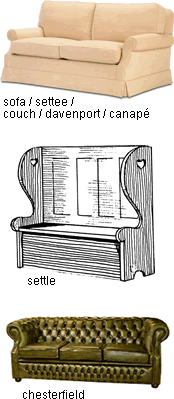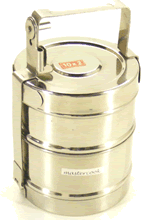Here’s a recording in a mystery language.
Can you identify the language, and do you know where it’s spoken?
Here’s a recording in a mystery language.
Can you identify the language, and do you know where it’s spoken?

The other day I discovered that one French word for sofa is canapé (/kanape/), and that canapé-lit or canapé transformable/convertible is a sofa bed. The word sofa is also used in French, and canapé can also mean an open sandwich.
According to the OED, in English canapé (/ˈkænəpɪ/) can mean both “A piece of bread or toast, etc., on which small savouries are served.” and “A sofa”. I’ve never come across it used to mean sofa in English, and had always assumed that canapés were small items of food similar to tapas. I think such things are also known as appetisers or hors d’oeuvres.
Canapé comes from the Medieval Latin canāpēum, from canōpēum (mosquito curtains; pavilion, tent, bed), from the Latin cōnōpēum (seat with a baldaquin*), from the Ancient Greek κωνωπεῖον (kōnōpeion – an Egyptian bed or couch with mosquito curtains), from κάνωψ (kánōs – gnat, mosquito). In English the word came to mean mainly curtain or canopy, which comes from the same root, while in French and other Romance languages its primary meaning became sofa or couch.
Sofa /ˈsəʊfə/ probably arrived via the Turkish sofa from the Arabic صفة (súffa – a long seat made of stone or brick).
Settee /sɛˈtiː/ is probably a variant of settle /ˈsɛt(ə)l/, “a long bench, often with a high back and arms, with storage space underneath for linen.” [source]. Settle comes from the Old English setl, from the Germanic *setlo-, from the pre-Germanic *sedlo-, from the Proto-Indo-European *sed-lo-, from *sed- (to sit).
Couch /kaʊtʃ/ comes from the French couche, from the Old French culche, which is cognate with coucher (to sleep), which comes from the Latin collocāre (to lay in its place, lay aright, lodge) from com- (together) and locāre (to place).
*Baldaquin /ˈbældəkɪn/ = “A structure in the form of a canopy, either supported on columns, suspended from the roof, or projecting from the wall, placed above an altar, throne, or door-way”.
What do you call your a long padded seat designed for two or more people? If it can be converted into a bed, what do you call it?
For my parents such a piece of furniture is a settee, and I used to use this name as well. Now I usually call it a sofa. We also have a piece of furniture that came from my grandparents and that we call a settle – a long wooden seat with a high, straight wooden back, wooden arms and a narrow seat with a cushion on top. The seat also lifts up and we store board games inside.

I encountered the word tiffin the other day as the name of type of cake and wondered where it comes from.
According to the OED, tiffin is a light midday meal or luncheon in India and neighbouring eastern countries. It is also used as a verb meaning ‘to take tiffin/lunch’ or ‘to provide with tiffin’.
It is thought to derive from the English slang/dialect word tiffing, from the verb to tiff, which means ‘to take a little drink or sip’. The origins of tiff are unknown.
Tiffin is used to refer to snacks between meals in southern India and Nepal. Elsewhere in India tiffin might be a packed lunch, which is often delivered by dabbawallahs or tiffin wallahs on bicycles in places like Mumbai, and is packed in a lunch box known as a tiffin carrier, a tiffin-box, a dabba or a tiffin (see picture top right). Such lunches may contain such things as rice, curry, vegetables, dal, chapatis or spicy meats.
In the early 19th century the British custom of having a large meal during the afternoon was found to be less than ideal for the hot climate of India, and British inhabitants of India acquired the Indian custom of a light meal at midday and a larger meal in the evening. The earliest reference to tiffin in the OED dates back to 1800.
Sources: Wikipedia & World Wide Words
The tiffin cake I ate contained chocolate, dates, crushed biscuits, raisins and other goodies, and was rather tasty. There are recipes for this type of tiffin here and here.
I spent yesterday in Aberystwyth with two Czech friends and we talked in a mixture of Czech, Welsh and English, with occasional bits of other languages thrown in for good measure. When they were speaking Czech to each other I found that I could understand or guess enough to get a basic idea of what they were talking about, and in some instances I could understand quite a bit more.
While I have been learning Czech on and off (more off than on in fact) for quite a few years, I rarely get the chance to listen to Czech conversations, apart from on online radio, and I was pleased to recognise quite a few of the words and phrases my friends were using. I couldn’t contribute much to the Czech parts of the conversation myself, but that will come with practise.
Quite a lot of the vocabulary and structures they were using have appeared in my Czech courses or in Czech texts I’ve read, so I was at least somewhat familiar with them already. Hearing these things used in context really helped to fix them in my mind. It also helped that I could ask about anything I didn’t understand – this is not possible when I’m listening to online radio or watching films or TV programmes.
This kind of immersion can happen anywhere you can find some native speakers of a language you’re learning (L2) who are willing to help you. Being in a country where your L2 is spoken is an even better form of immersion, but might not be possible for everyone.
Here’s a recording in a mystery language.
Can you identify the language, and do you know where it’s spoken?
According to an article I found today, l’Assemblea regionale siciliana (the Sicilian Regional Assembly) has voted unanimously in favour of the introduction of lessons in Sicilian language and culture in Sicily’s schools at all levels from next year. The aim is to preserve “l’immenso patrimonio storico e letterario della Sicilia” (the immense historical and literary heritage of Sicily). How this will be implemented, much it will cost and whether there are sufficient qualified teachers are issues that still need to be dealt with.
Perhaps a better way to encourage the continued use of Sicilian would be to use it as a medium of instruction, at least at primary level.

Yesterday I discovered an interesting new word – occlupanid, which is defined by the Holotypic Occlupanid Research Group as follows:
“Occlupanids are generally found as parasitoids on bagged pastries in supermarket biomes, although a few species are found on vegetables and bulk grains, and one notable species (Uniporus) is found exclusively on vent tubing bags. Their fascinating and complex life cycle is unfortunately severely under-researched. What is known is that they take nourishment from the plastic sacs that surround the bagged product, not the product itself, as was previously thought. They often situate themselves toward the center of the plastic bag, holding in the contents. This leads to speculation that the relationship may be more symbiotic than purely parasitic.”
The common name for occlupanid is apparently breadtie, and the HORG is dedicated to the taxonomic classification of the breadties of the world. They provide details about different species of occlupanid – the one on the right is an archignatha (“first tooth”), for example – the morphology of their names, and their taxonomy and history. The term occlupanid comes from the Latin occlūdere (to shut up, to close) and the Greek παγ (pan – bread), which is also found in pancreas (“sweet bread”).
What do you call these things?
Y prynhawn ‘ma bydda i’n canu efo’r Côr Cymunedol Bangor ym Mîts Botaneg yng Ngardd Fotaneg Treborth. Gobeithio bydd hi’n braf, ond ar ôl rhagolygon y tywydd, bydd hi’n gymylog ac efallai efo cawodydd.
Nos Wener es i i gyngerdd wych yn y prifysgol. Cyngerdd olaf y blwyddyn academaidd ydoedd ac roedd cryn dipyn o grwpiau cerdd yn perfformio.
Here’s a recording in a mystery language.
Can you identify the language, and do you know where it’s spoken?